Wet and dry food: what is the best way to feed your cat?
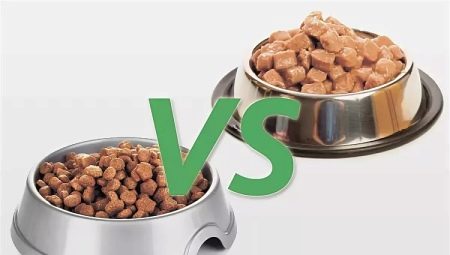
For many years there has been a debate about the correct feeding of domestic cats, neither breeders nor veterinarians have come to a consensus. What is preferable for pets - natural food, dry or wet food? Is it possible to combine wet and dry formulations, which feed manufacturers should you choose for your beloved animals? You will find the answers to these questions in our article.

Comparison of composition
Ready-made store food for cats is gaining more and more popularity among breeders and there are several reasons for this.
- The food does not need to be cooked - the owner is only required to pour it into the saucer in the specified volume, this is quite convenient and saves time.
- High-quality feed has a balanced composition - it contains proteins, carbohydrates, fats in the required dosages, in addition, they are enriched with vitamins, microelements and essential amino acids.
- Of course, nothing has been invented better than natural food, but it is no secret that in order to compose a balanced full-fledged diet, especially for purebred cats that are extremely fastidious in nutrition, it takes a lot of effort, as well as time and money. Ready-made feed completely solves this problem.
- Another indisputable advantage is the convenience of their storage, natural products very quickly begin to deteriorate, and store formulations can be bought in large quantities at once.


All types of dry and wet food are produced in several versions.
- Economy - the cheapest, widely advertised type of feed, but at the same time the most useless and even dangerous. The product is made from wastes of the meat-processing industry - hooves, bones, fats and skin, and the basis is soy and legumes.
There are no vitamins, minerals, probiotics and amino acids here, in fact, it is just a stomach filler that creates a temporary feeling of fullness. Your furry will not receive any benefit from such feeding.

- Premium and super premium Are mixtures made from natural meat. The composition of the product is balanced and contains all the vitamin and mineral supplements necessary to maintain the activity and health of a pet. These are more expensive feeds, they can be purchased exclusively in specialized stores, but they, as a rule, fully satisfy all the animal's needs for proteins, carbohydrates and fats.

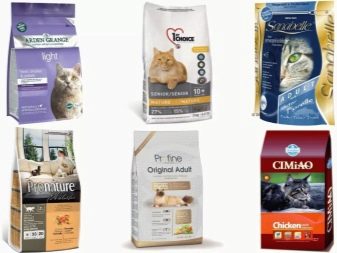
- Holistic - these are the most expensive feeds, the composition of which is as close to natural as possible. The basis is taken from natural meat, herbs and vegetables, which are grown without the use of hormones and antibiotics; preservatives and all kinds of flavor enhancers are not included in the product. Such products can only be purchased on order.

- Therapeutic - This is food for cats that have certain health problems. Keep in mind that such mixtures should not be given to animals for prophylaxis, from such "care" the animal, on the contrary, will only get sick.

Depending on the consistency, feed is divided into wet and dry.
- Dry are compressed granules, the water content in them is minimal. As they enter the digestive system, they begin to absorb liquid, therefore, when feeding an animal with such products, it is very important to carefully monitor that the pet receives the required amount of water.
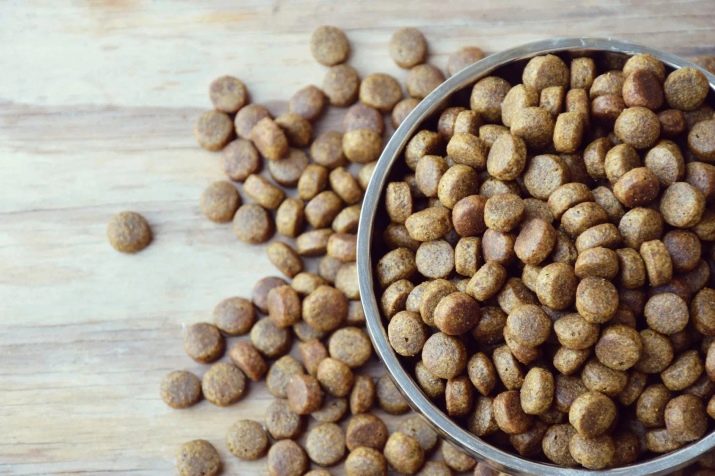
- Semi-moist feed - these are pieces of the product in a jelly-like sauce. The product has a limited shelf life after opening the package. Pastes are also referred to semi-moist feeds: in fact, these are the same products, only more chopped. This product is optimal for small kittens and adult cats with sore gums and teeth. For healthy pets, such feeding is irrelevant, cats' teeth will remain healthy only when they use them.

- Separate category of feed - These are delicacies, such as dried meat and gnawing sticks. Such products are not used as a main food, only as a reward.



Pros and cons of feed
There is no unequivocal answer to the question of which food is better to feed the animals - wet or dry, it all depends only on the animal's taste preferences. Each of the products has both advantages and disadvantages.
Dry
Advantages:
- dental health - veterinarians note that the use of dry food contributes to the sliding of tartar and plaque, the product does not contain water, so the pet gets it from the outside, which also helps to clean the teeth;
- dry food is more economical: one package lasts for a long time, so the product does not deteriorate for a long time and is often sold in large packages, so you can buy food in bulk for several months in advance;
- dry food will become a good opportunity to strengthen the jaw muscles - the product fully satisfies all the chewing instincts of cats and cats.
Now let's talk about the cons.
- Dry food contains higher concentrations of carbohydrates. Representatives of the feline family are carnivores, the food they get in nature does not contain cereal grains, which are present in large quantities in dry food (they are added as a source of carbohydrates). Usually, the proportion of cereals in mixtures is 30-50%, this can cause diabetes in an animal.
- If the cat has been kept on wet or natural food for a long time, then its digestive system is used to assimilating high-protein food and it will become a rather difficult procedure to digest dry food.

Wet
Pros:
- wet mixtures are an optimal source of proteins and fats in a form that matches the physiological characteristics of animals, feeding with such food does not cause constipation in pets;
- 70% wet feed consists of water, so animals do not need abundant supplementation;
- studies have shown that cats eat less when eating wet foods, so the use of such food helps protect the pet from overeating - animals quickly achieve a feeling of fullness, which lasts for several hours;
- Appetizing Taste and Smell - Pets generally love the aroma and texture of wet food.
Minuses:
- Wet food is more expensive than dry food;
- wet food has a limited shelf life, so they are usually packed in small jars or bags;
- the use of such formulations often causes bad breath; in some cases, animals develop plaque and calculus, which often cause gum disease.

Can I mix?
According to the manufacturer's recommendations, mixing of dry and jelly-like feed is allowed, but only if both products belong to the same brand. Also, manufacturers do not recommend combining ready-made store products with natural food, nevertheless, many breeders from time to time still introduce meat or other protein ingredients into their pet's menu.
In fact, there is nothing dangerous about mixing several types of feed, but it is important to adhere to certain rules. Firstly, food should not be combined within the same feeding. In this case, three problems are possible:
- it is difficult to design the menu so that it is balanced;
- When mixing feeds, it is difficult to track the flow of the required volume of water into the animal's body: if a cat ate wet food immediately after dry food, then she may completely refuse to drink the water she needs so much.
- dry and wet foods in the pet's body are digested at different rates, which can lead to serious eating disorders in the pet.
Thus, if you intend to combine both types of food, then meals should be separated in time, for example, dry food in the morning and wet food in the evening.
Secondly, you should be very careful when combining ready-to-eat foods with natural foods. If you are determined to combine ready-made feed with natural products, then it can only be protein components - meat, high-quality offal or fish. Supplementary feeding of pets with cereals, sour milk, vegetables and fruits is not allowed, they get everything they need from the finished feed composition.
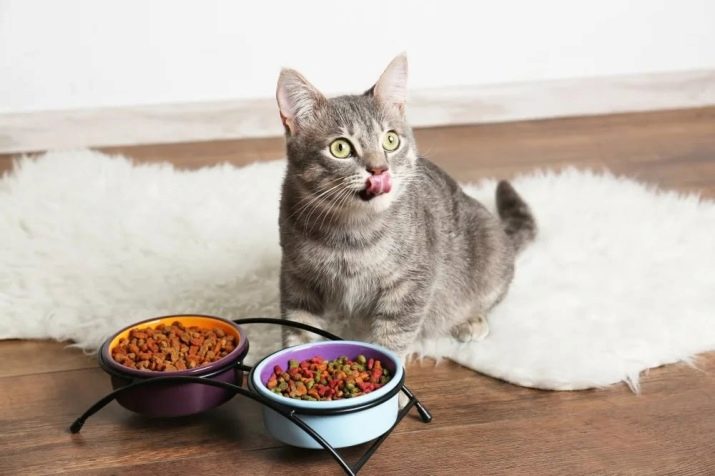
How to define quality?
Many breeders buy on advertising and choose products for their pets that, in fact, turn out to be not only unhealthy, but even dangerous for animals. When choosing the optimal food for your pet, do not believe the advertisements and the picture on the package - for sure you will see an image of a well-fed healthy cat. The only thing that should really get your attention is the information about the ingredients.
The composition should be completely "transparent" - all ingredients should be prescribed there with full indication of the type of product, for example, feed should contain beef / veal / chicken, and not "meat products" - this formulation is rather vague and may imply ground tendons, bones, skins, etc. fats, and not at all high-protein components, so necessary for pets.
Pay attention to the concentration of foods. If the packaging indicates that the product contains 4% meat, it means that only 4 g of meat per 100 g of feed, it should be well understood that no animal will have enough of this amount of protein for one meal.
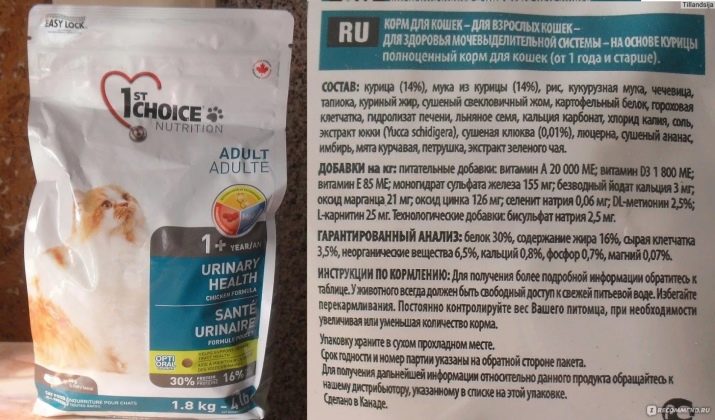
Please note that the composition on the package is usually indicated in descending order of mass fraction, and here unscrupulous manufacturers often go for some tricks. For example, they include quite a lot of grain additives, but at the same time in minimal concentrations. Thus, all of them are indicated at the end of the list of products and, at first glance, their content is small, but if you sum up the total content of the components, you will notice that their dosage significantly exceeds the recommended one.
Keep in mind that the longer the feed is stored, the more likely it is to contain preservatives and other synthetic additives.

Another important point is the integrity of the packaging. Do not buy dry food by weight. The fact is that opened wet food can be stored for only a few hours, and dry food for several months is oxidized and becomes absolutely useless for the animal, in some cases even harmful. In addition, sellers often sell stale goods in this way, mixing them with granules from a freshly opened bag. Keep in mind that the sale of feed by weight should be carried out exclusively from hermetically sealed containers, and not from bags.
See below for how to choose cat food.
































